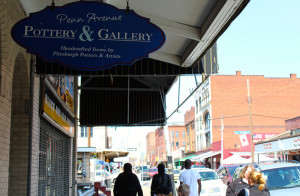Penn Pottery: Heart Like a Wheel
By Alex Mell
After Gary Pletsch prepares the clay purchased from his hometown Standard Ceramics in Carnegie, he sits at the shaping wheel and effortlessly moves his fingers through the soft, wet clay to transform it into a large bowl. The piece will need finishing: Creative thoughts about the designs he wants on the bowl, the actual carving of the piece, two separate firings, and glazing. If all goes as planned and there aren’t any cracks or dripping glaze, the bowl will be ready for retail in four to five weeks.
“There is no immediate gratification,” Pletsch says of the process of turning the clay into a piece of pottery.
The Strip District is bursting with small specialty shops and boutiques that don’t generate a great deal of publicity but have managed to survive for decades. Penn Avenue Pottery, located at 1905 Penn Avenue, is one of those shops. It has been in business for 33 years.
In 1979, Bill Foglia opened the store when his father chose to retire from his Italian grocery store and give the space to his son. Foglia transformed the grocery store into a ceramics studio and operated on his own for almost 10 years.
Foglia decided he wanted to teach and found a job in the Fox Chapel School District, where he taught fourth grade for 14 years and elementary art for eight years. During that time, Foglia rented the front of the shop to a woman named Lilly, and she named the store “Artisan Show Place.”
In 1989, a few of the potters who sold pieces at Artisan Show Place decided they wanted to come together and help the store. In September of 1990, the shop went back to its original name of Penn Avenue Pottery with a new group of potters that turned the store into the small art gallery it is now. Artists Valda Cox and Pletsch continue to work at and help run Penn Avenue Pottery today. “We are our own private art show,” Pletsch says.
“We are a 365 day-a-year art festival.” Customers who venture into the store are greeted by the overwhelming variety of pottery that artists have crafted: A mixture of mugs, plates, wall pieces, and other odds and ends in shades of reds, browns and blues. Guests can look to the back of the shop and see the potters working at their craft.
Penn Avenue Pottery is run by a group of five individuals who form the co-op. Along with Foglia, Pletsch and Cox, Mike Gwaltney and Tracey Donoughe labor at their craft. These potters have over 100 years of combined experience. The main thing that keeps them going: The clay.
“When people get their hands in clay, there is something that draws them to it,” Foglia says. “Whether it’s the texture or the feel of the clay on your hands, people enjoy doing pottery.”
The shop’s location in one of the busiest, familyrun shopping areas in the entire region has aided its success. People come to the Strip for a kind of authenticity that cannot be found at the mall.
“Subway and Starbucks came here and didn’t last: Chains don’t seem to last,” Pletsch says. “It just shows how loyal the customers are to the businesses in the Strip.”
The fervor of Penn Pottery customers is evidenced by the fact that the shop doesn’t spend a dime on advertising. People learn about Penn Avenue Pottery by visiting the store and they see the artists’ work on display at other venues, such as potlucks or charities. Current customers tout the shop to new customers.
“Since we are a small business, we don’t need the hi-tech devices,” Pletsch says. “We advertise through word of mouth.”
Foglia, with his salt-and pepper-hair and claydust covered hands, focuses intently on covering the bottoms of his pieces with a wax that protects them from glazing when placed in the kiln.
“One of the things about pottery that’s different from other crafts is the different steps involved,” Foglia says. Before the potter can begin shaping the clay, it must first be wedged so that there aren’t any bumps or air pockets in the clay. Wedging clay is similar to the process of kneading dough. After wedging, the clay is wetted and shaped on the wheel into whatever shape the potter decides. After the piece is formed, it must dry a bit before the potter carves any patterns for finishing. The piece is then fired two separate times before the glazing is applied.
As Pletsch wedges a fresh block of clay, wets it and puts in on the table to be shaped, his love for the art is obvious. With focus and ease, he turns a block of clay into a beautifully crafted bowl in less than five minutes. The finished product won’t be available for another few weeks, but the process has begun.
“Each day of the week, a different potter works and we rotate on Saturday and Sunday,” he says. Like most shops in The Strip, the busiest business day for Penn Avenue Pottery is Saturday.
Pletsch sits in his chair with his black-rimmed glasses and dirty work pants and focuses on the newest design that has come to him as he carves a mug he recently sculpted. He is known for his heavily carved pieces with different symbols and patterns ranging from doodles (a habit from his days as a student when he should have been taking notes), to the rope lava flows of Hawaii.
“I look at buildings a lot for design ideas,” Pletsch says. “Manhole covers and tree grates also have beautiful patterns.”

 Previous Post
Previous Post Next Post
Next Post